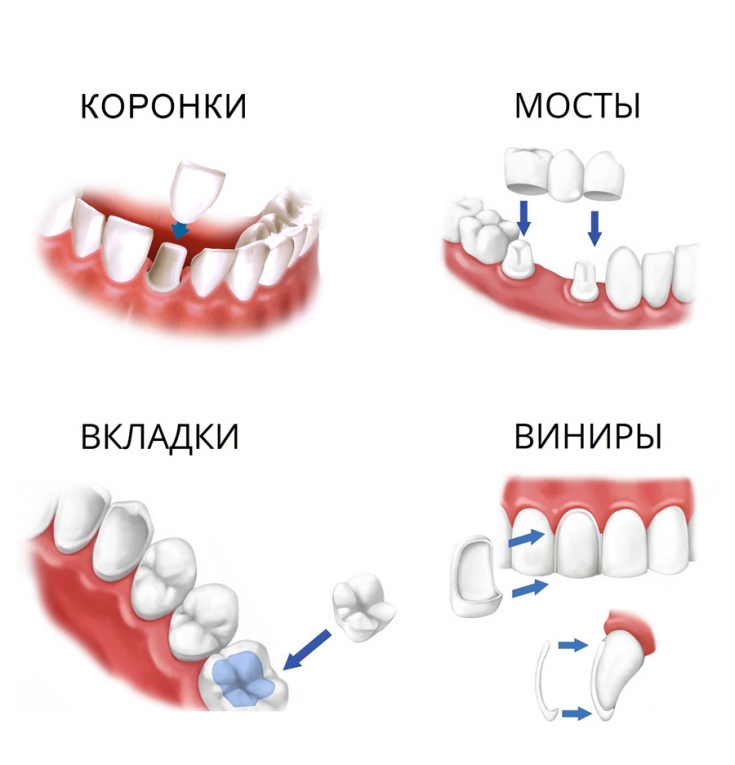Dental bridge – it is an orthopedic design that is often used in dentistry. It is relevant when there is significant destruction of several teeth at once in a row or there are none at all.
The product is artificial teeth, which are interconnected in one row. Such prosthetics makes it possible to immediately notice several teeth.
But why then doesn't everyone want to build a bridge? The editors of estet-portal.com will talk about the positive and negative aspects of the design, and also tell about the indications for their use and the specifics of care.
1. Dental bridges: the main types of such prostheses
2. Dental bridge: what are the advantages of
3 construction. Disadvantages of installing a dental bridge
4. Dental bridge: indications and contraindications
5. Dental Bridge Care Rules
Dental bridges: the main types of such prostheses
The types of bridges depend on such indicators as material, degree of fixation and manufacturing technology.
The following types of structures are distinguished:
• solid cast, which are made in special laboratories of dental technicians and naturally have the highest strength;
• adhesive, when the dentist can model the bridge directly in the oral cavity;
• stamped, which are heavy today are rarely used by modern dentistry.
If we talk about the choice of material, then crowns for teeth are divided into types:
• made of metal, which are distinguished by low cost and durable material, but have low aesthetic characteristics;
• metal-ceramic prostheses, look natural, safe and durable, combine quality-price;
• made of plastic are lightweight and low cost, but installation is recommended for a short period of time;
• from zirconium – expensive, but reliable option, they look attractive and have high strength.
Follow us on Instagram.
Dental bridge: what are the advantages of the design
Which type of prosthetics to prefer and whether to put a crown on the tooth, the patient decides after consulting with his dentist.
The relevance of bridges is increasing due to their advantages:
• attractive natural appearance, because the structure is difficult to distinguish from your own teeth by external signs;
• the possibility of installing 3-4 teeth at once, which will allow you to fully restore the chewing function;
• minimum time to get used to prostheses, which range from 8 to 12 hours;
• setting the structure does not affect diction;
• availability in the price segment, especially if you have chosen a cheap material for the prosthesis.
Disadvantages of a dental bridge
Despite the positive aspects, many resort to other options for prosthetics. What is it about?
There are two drawbacks to the design, but they are significant:
• firstly, in order to install a dental bridge, it is necessary to grind the abutment teeth for which it will be attached, and not every patient wants to cut off half of a healthy, usually tooth;
• secondly, there will be an increased load on the abutment teeth, because it is they who hold the structure, as a result, traumatic occlusion of the abutment teeth appears.
Keep in mind that the installation of a dental bridge goes through several stages. To begin with, the doctor conducts an examination, if necessary, the teeth of the support are treated, and then they are undermined for prosthetic crowns.
Bridges are non-removable structures.
Dental bridge: indications and contraindications
Of course, your desire to install the structure alone will not be enough.
Indications for prosthetics are:
• the presence of defects in the lateral or anterior part of the dentition (2-4 teeth);
• absence of one molar for chewing function;
• the presence of healthy supporting teeth so that they can serve as a support and withstand the load.
Among the contraindications are:
• the presence of acute inflammatory processes in the mouth and throat;
• bruxism;
• malocclusion;
• the presence of complex forms of periodontal disease;
• diseases of the bone tissue of the jaw;
Dental Bridge Care Rules
If you have bridges installed, this does not mean that you can brush your teeth less often, because they will not deteriorate.
To ensure that the design lasts a long time and does not cause inconvenience, follow these rules:
• brush your teeth 2-3 times a day;
• rinse your mouth after eating;
• pick up fluoride toothpaste;
• the brush must have soft bristles;
• the gaps between the teeth are best cleaned using an irrigator, dental floss or a brush;
• visit the dentist 2 times a year.
By following simple measures to care for your orthopedic structure, and knowing how to properly brush your teeth, you will be able to prevent gum and tooth disease and ensure the longevity of dentures.
Insufficient care of the dental bridge leads to severe toothache. To avoid removing the prosthesis, follow the rules for caring for the structure.
As you can see, it is important to weigh the pros and cons before installing a dental bridge. Types of prostheses allow you to choose the appropriate option for each with minimal trauma to the teeth that serve as a support.
An important role in the choice is played by the cost, which directly depends on the material of the prostheses. Your dentist will definitely recommend the best ratio for your case.
And to avoid prosthetics, start right now to monitor the oral cavity as dentists advise, and not as we are used to in the modern pace of life.
Dental implants or investing in treatment: what is more profitable
You might be interested in: How a filling is placed.








Add a comment